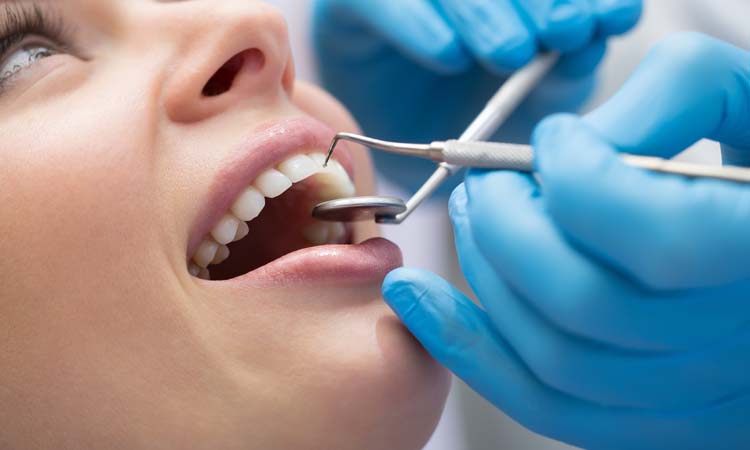Pathology
What Is Oral Pathology?
Pathology, in general, is the study of disease. An oral pathologist is an expert of diseases and pain disorders affecting the oral and facial region.
Sometimes, oral pathology cases involve oral cancer. There are many symptoms of mouth cancer. Occasionally, lumps or sores can form inside the oral cavity, which may be a sign of a pathologic process, or cancerous growth. The most serious of these is oral cancer.

What Are Some Symptoms of Oral Cancer Or Other Abnormalities?
Common symptoms of oral cancer and other abnormalities may include (but are not limited to) the following:
- A lump or thickening on the gum lining
- Red or white patches in the oral cavity
- Difficulty swallowing or chewing
- Sores that bleed easily or heal slowly
- Reddish or whitish patches in the mouth
- A sore that fails to heal and bleeds easily
- A lump or thickening on the skin lining the inside of the mouth

Who is at risk for oral cancer?
Individuals at high-risk factor are patients who smoke or chew any form of tobacco and drink alcohol (the risk is higher in those who smoke and drink at the same time). Patients with a weaker immune system have a higher risk of contracting oral cancer. Studies have also shown that patients have more chances to get oral cancer if they have HPV infection (human papillomavirus).
Diagnosis and Treatment
All abnormal lesions or findings which are present for more than two weeks should be evaluated by an oral and maxillofacial surgeon like Dr. Jing and biopsied if indicated and necessary. A biopsy involves removing a small piece of a lesion for laboratory evaluation & diagnosis. Other lesions or cysts may also be associated with wisdom teeth, and may not be noticed until routine x-rays are taken.
As oral pathology is a broad science that deals with diseases of the mouth in general, the course of treatment is established on a patient-specific basis.
Bone Cysts and Jaw Tumors
Although not exceedingly common, cysts and tumors can develop in the jaw bone. They can be completely asymptomatic and discovered on a routine x-ray. On occasion, the cyst or tumor can reach large sizes, causing pain, discomfort and disfigurement. Benign or malignant lesions can also occur on the soft tissues of the oral cavity. All lesions in the mouth or jaw need to be evaluated and possibly biopsied.
Examples of cysts and jaw tumors we treat include:
- Ameloblastoma. This is a rare, slow-growing, usually noncancerous (benign) tumor. It develops most often in the jaw near the molars and can invade local structures such as bone and soft tissue.
- Keratocystic odontogenic tumors. Also called odontogenic keratocysts, these slow-growing, benign cystic tumors can be destructive to local structures and often recur. Most often the cyst develops in the jaw near the third molars. These tumors may also be found in people with an inherited condition called nevoid basal cell carcinoma syndrome.
- Nevoid basal cell carcinoma syndrome. Also called Gorlin-Goltz syndrome, people with this condition lack a gene that suppresses tumors. The genetic mutation that causes the syndrome is inherited. This syndrome results in early-age development of multiple basal cell skin cancers and keratocystic odontogenic tumors in the jaw.
- Odontoma. This is a benign tumor made up of dental tissue that grows around a tooth in the jaw. Odontomas can resemble an oddly shaped tooth or can be small or large calcified tumors. These may be part of some genetic syndromes.
- Odontogenic myxoma. An odontogenic myxoma is a rare, slow-growing, benign tumor that occurs most often in the lower jaw and soft tissue. The tumor can be large and aggressively invade the jaw and surrounding tissue. Odontogenic myxomas can reoccur after treatment.
- Central giant cell granuloma. Central giant cell granulomas are benign lesions that most often occur in the front portion of the lower jaw. The tumor’s rapidly expanding growth can destroy bone. Rarely, a tumor may shrink or resolve on its own, but generally it increases in size without treatment. Management may be medical, surgical or both.
- Other types of cysts and tumors. These include adenomatoid odontogenic tumors, calcifying epithelial odontogenic tumors, ameloblastic fibromas, dentigerous cysts, glandular odontogenic cysts, squamous odontogenic tumors and calcifying odontogenic cysts.
Treatment of Bone Cysts and Jaw Tumors
Treatment options for jaw tumors and cysts vary, depending on your symptoms, the type of lesion you have, and the lesion’s stage of growth. In rare cases, medications may help, but they usually require surgical management.
Dr. Jing has extensive experience in diagnosing and treating benign cysts and tumors of the jaw. He will clinically and radiographically evaluate the lesion or infection and discuss your treatment needs during your initial consultation.
When a large portion of the upper or lower jaw is removed due to a cyst or tumor, reconstruction surgery is often needed. Typically, reconstruction is performed in staged procedures to optimize the outcome, or may sometimes be performed at the same time. Dr. Jing utilizes 3-D technology to assist him with the excision of jaw tumors. ENT or plastic surgeon will assist Dr. Jing with reconstruction through harvest of free grafts stabilized with a reconstruction plate in essence creating a new jaw for the patient. Dental rehabilitation will be completed with prosthodontist after recurrence has been ruled out.
Lifelong, regular follow-up exams after treatment by Dr. Jing can address any recurrence of jaw tumors and cysts early.
We will be happy to answer any questions on oral pathology
Feel free to drop in during walk-in hours to see Dr. Jing for further information
